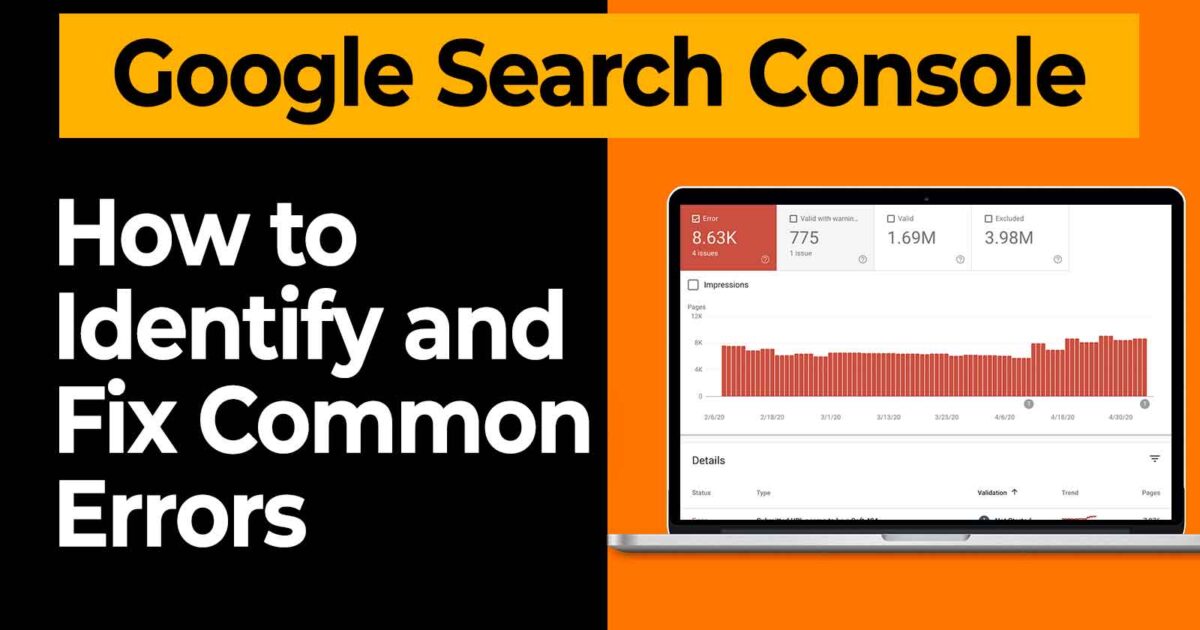
Google Search Console (GSC) is a cornerstone tool for webmasters and SEOs. Formerly known as Google Webmaster Tools, GSC provides insights into how Google views and interacts with your website.
Despite its importance, many users encounter common issues that can hinder site performance, such as incorrect indexing or ranking problems. This article delves into the most frequent errors, their identification, and actionable strategies for resolution. Let’s explore how you can optimize your website using Google Search Console.
Table of Contents
Understanding Google Search Console Errors
Google Search Console serves as a diagnostic hub for your website. By regularly monitoring it, you can detect errors that may negatively impact visibility and user experience. Here are the most common errors and how to tackle them effectively:
1. Indexing Errors
Indexing errors occur when Google fails to index your pages properly. Unindexed pages result in reduced visibility and lost traffic potential. These errors typically stem from problems in your sitemap, robots.txt file, or technical issues.
Steps to Fix Indexing Errors:
- Check Your Sitemap: Ensure your sitemap is submitted to GSC and includes accurate, accessible URLs. Address broken links or outdated pages.
- Verify Robots.txt File: Confirm that your robots.txt file isn’t inadvertently blocking important pages.
- Use the URL Inspection Tool: Identify non-indexed URLs and request indexing directly through GSC.
2. Crawl Errors
Crawl errors occur when Googlebot encounters issues accessing your website’s pages. These errors are categorized into site-level errors (e.g., server issues) and URL-specific errors (e.g., 404 errors).
Steps to Fix Crawl Errors:
- Fix Broken Links: Use the Coverage report in GSC to identify and fix or redirect 404 errors.
- Optimize Server Performance: Ensure your hosting provider can handle traffic efficiently, reducing server downtime.
- Review URL Structures: Avoid overly complex or erroneous URLs that could confuse crawlers.
3. Mobile Usability Errors
With Google’s mobile-first indexing, mobile usability is a critical SEO factor. Issues such as small text size, closely packed elements, or viewport misconfigurations can hurt your rankings.
Steps to Fix Mobile Usability Errors:
- Implement Responsive Design: Ensure your website adapts seamlessly to all screen sizes, from smartphones to desktops.
- Use AMP (Accelerated Mobile Pages): Enhance mobile speed and performance using AMP frameworks.
- Test Usability: Utilize GSC’s Mobile Usability report to identify and resolve specific issues.
4. URL Has No Enhancements
This error indicates a lack of structured data or rich snippets on your page, reducing its potential appeal in search results.
Steps to Resolve This Issue:
- Add Structured Data: Use Schema.org markup to enrich your pages with structured data for products, reviews, FAQs, and more.
- Test Rich Snippets: Validate your structured data using Google’s Rich Results Test tool.
5. Sitemap Errors
Sitemaps play a vital role in guiding Google through your website’s structure. Errors such as incorrect formatting or inaccessible URLs can hinder crawling.
Steps to Fix Sitemap Errors:
- Submit a Correct Sitemap: Ensure your sitemap follows XML standards and includes all valid, reachable URLs.
- Check URLs: Verify that every URL listed in the sitemap is active and accessible.
- Regular Updates: Update your sitemap whenever you add or remove significant site content.
6. Manual Actions
Google issues manual actions when a website violates its guidelines, such as hosting spammy content or engaging in link schemes. These penalties can significantly lower your rankings or even remove your site from search results.
Steps to Resolve Manual Actions:
- Review the Manual Actions Report: Identify specific violations flagged by Google.
- Correct Issues: Remove spammy backlinks, duplicate content, or other flagged problems.
- Submit a Reconsideration Request: Once resolved, request Google to review your site for compliance.
Proactive Monitoring and Prevention
Addressing errors is crucial, but consistent monitoring helps prevent future issues. Here’s how you can maintain your website’s health using Google Search Console:
1. Perform Weekly Checks
Regularly review GSC’s Coverage and Enhancement reports to catch and resolve new errors promptly.
2. Set Up Email Alerts
Configure notifications in GSC to receive updates on crawling, indexing, or manual actions.
3. Conduct Technical Audits
Leverage tools like Screaming Frog or Ahrefs for in-depth SEO analysis, uncovering potential issues overlooked by GSC.
4. Monitor Mobile Performance
Given the dominance of mobile searches, ensure your site’s mobile performance meets Google’s standards.
5. Stay Updated on SEO Trends
Google frequently updates its algorithms and guidelines. Stay informed to ensure your website remains compliant and competitive.
Google Search Console is an indispensable tool for optimizing your website’s performance. By identifying and addressing common errors like indexing issues, crawl errors, and mobile usability problems, you can improve your site’s visibility and user experience. Remember, proactive monitoring and regular updates are key to staying ahead in the ever-evolving SEO landscape.
Harness the full potential of Google Search Console today to ensure your website thrives in search engine rankings. Consistent effort and strategic use of GSC will keep your site error-free and highly competitive.









